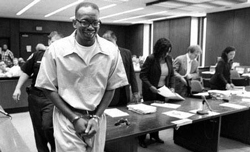Picture yourself in a small prison cell. The long years have been passing. Thinking back on it, you can hardly remember when exactly it was you were put there, but you know one thing; you were innocent and you have been serving time in place of the true criminal.
There is hardly any hope and freedom may never come. It is in this type of desperate situation that organizations such as the Innocence Project step in.
Elizabeth Webster, the publications manager from the Innocence Project, was a guest speaker at the University last Thursday during Professor Susan Douglas’ class in the History Department.
Webster spoke about the mission of the Innocence Project, the type of work the organization does, and the inherent flaws in the current U.S. legal system.
The Innocence Project works on using DNA evidence to prove the innocence of wrongfully convicted felons, hopefully leading to their exoneration. The organization was founded at Yeshiva University in 1992 by two lawyers, Barry C. Scheck and Peter J. Neufeld. It began as a small legal clinic that used DNA evidence to prove innocence, but due to the growing number of service requests, it eventually grew to become the national non-profit organization it is today.
While the exact number is not known, the current percentage of wrongfully convicted criminals in the U.S. judicial system is high.
Webster said, “The figure is somewhere in the hundreds or thousands, suspected to be between three and seven percent of the prison population.”
In a system based on the philosophy that guilty verdicts should not be delivered under any amount of reasonable doubt, why are so many innocent people going to jail?
 The answer to this question is divided into three main categories: eyewitness misidentification, improper or invalidated forensics, and false confessions.
The answer to this question is divided into three main categories: eyewitness misidentification, improper or invalidated forensics, and false confessions.
The current way in which investigations are conducted is highly flawed.
Witness misidentification happens because of the human tendency to place the blame.
It has been shown that if witnesses are not informed that the perpetrator may not be among potentials shown in a line-up, that nearly 100% of the time the witness will still pick someone and claim that person to be the assailant.
One of Webster’s most interesting points was that forensic techniques glorified by shows like Law and Order or CSI are not validated sciences.
In some cases, it has even been reported that scientists will take the stand, under oath, and claim that there is blood or hair evidence linking a defendant to the crime when no test was ever conducted.
The prevalence of false confessions is also a serious problem in the judicial system.
Police forces are legally allowed to lie about evidence in an interrogation to the end of gaining a confession?
Now this may not seem like a big deal to a lucid person who could identify these types of falsifications.
But take for instance, the cases of individuals with mental disabilities who may very well be convinced, after 72 hours of lies and aggression that perhaps they were responsible for the crime the police are insisting that they committed.
After all, aren’t the police working for the public? Should it not then be assumed their work is based on the truth?
It is issues like these that the Innocence Project seeks to tackle.
Apart from fighting for the exoneration of the wrongfully convicted, the organization assists the exonerated after their release from prison and advocates extensive policy reform.
Some examples include lobbying for the requirement that states record 100% of interrogations, making sure forensics labs are accredited and the scientific methods used are peer reviewed, and the organization also advocates a moratorium to not execute until the major legal problems are solved.
As Ms. Webster stated, there is a triple tragedy to wrongful conviction: an innocent person is imprisoned, the victim goes without justice, and the true perpetrator goes free.
Organizations like the Innocence Project are the first and only line of defense against these injustices.
If you would like to help remember, get connected, stay informed, and reach out, go to www.innocenceproject.org.
PHOTO COURTESY of www.nj.com
PHOTO COURTESY of Tyler Breder


